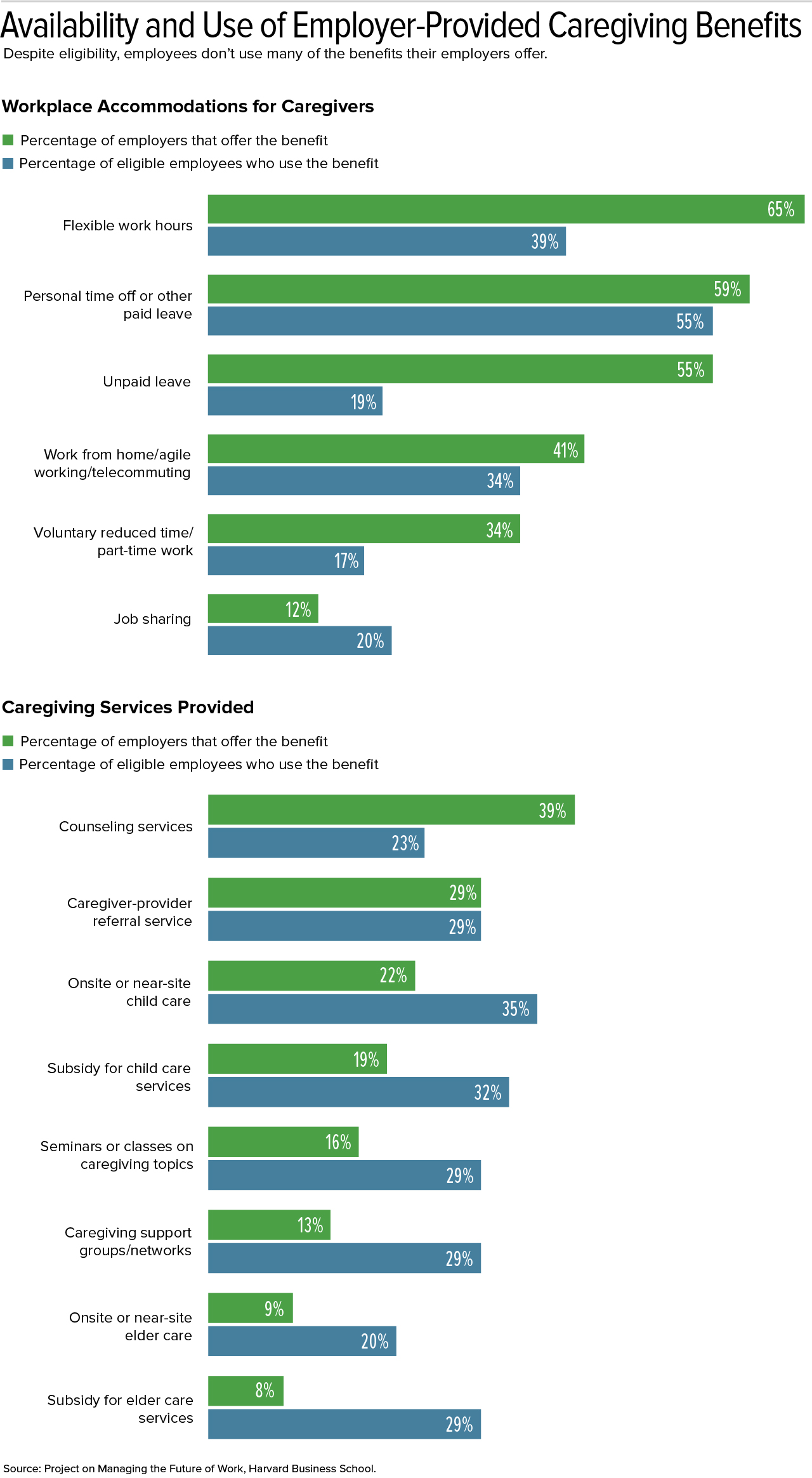Caregiving Benefits Tend to Miss the Mark
‘Caregiving crisis’ hurts employee productivity and employer profitability
 |
By Stephen Miller, CEBSJanuary 22, 2019 |

When employers offer caregiving-support benefits, the benefits often aren’t what employees say they most need.
Three out of four U.S. workers have caregiving responsibilities, and the vast majority of caregivers say that these responsibilities lower their productivity at work. At the same time, less than a quarter of employers think that caregiving affects worker performance.
The Caring Company, a January 2019 research report from Harvard Business School’s Future of Work Project, shows that a growing “caregiver crisis” is creating millions of dollars in hidden costs for U.S. firms from employee turnover and absenteeism. The report draws on a 2017 survey with responses from 1,547 employees in the U.S. who identified as caregivers and a 2016 survey of 301 HR leaders.
“Firms can gain a competitive advantage by investing in a care culture,” said report co-author Joseph Fuller, a Harvard Business School professor and manager of the Future of Work Project. “But first they need to recognize the problem and implement a deliberate care strategy to support their employees.”
Among the areas in which employers are falling short, for example, the report noted that:
- 52 percent of employers do not measure—and thus do not understand—the extent to which their employees are burdened by care.
- 24 percent of employers responded that caregiving influenced workers’ performance. Employers identified unplanned absences, missed days of work, late arrival at work and early departure from work—all of which are common among caregivers—as the top three behaviors that undermine employees’ career advancement.
In addition to lowered productivity, caregiving can lead employees to leave their jobs. Among employees who quit their jobs due to caregiving responsibilities:
- 57 percent left to care for a newborn or newly adopted child.
- 49 percent left to care for a sick child.
- 43 percent left to manage a child’s needs.
- 32 percent left to care for an elderly family member with daily living needs.
- 25 percent left to care for an ill or disabled spouse, partner or extended family member.
Misunderstanding the Benefits Employees Value
Too often, “benefits offered by employers are often not the benefits employees want,” the researchers found. As a result, employees’ aren’t getting the help they feel they need, and employers aren’t seeing improvements in retention and engagement among caregivers—especially when employees feel that their only option is to quit and become full-time caregivers.
“Some workers are reluctant to use available resources for fear of suggesting a lack of commitment to the organization. Others may not even be aware of the availability of benefits,” the researchers wrote.
“Many companies appear not to understand which benefits their employees most desire or which address their employees’ most pressing care needs,” the report points out.
Consider, for instance, a common misalignment on a benefit intended to reduce turnover. Employers perceive that one of the most effective benefits when it comes to retaining talent is offering subsidies for elder care services, with 92 percent of employers describing the benefit as either very effective or somewhat effective. Yet, fewer than 10 percent of employers offer the benefit, despite the fact that 32 percent of workers who left a position over care concerns did so because they had to care for a senior with daily needs.
Similarly, 78 percent of employees described referral services for caregivers as “very important” to their decision to stay with their firm. However, only 38 percent of employers considered caregiver provider-referral services as an effective benefit for retaining employees.
“The extent of this misalignment suggests that employers are poorly informed about the needs and preferences of their workforce and that employees do not have any ready mechanism for expressing those preferences,” the report explains.
The most significant factors that contributed to caregivers quitting were all in areas where employers could provide guidance, infrastructure or support, such as:
- The high cost of paid help (cited by 53 percent of workers).
- The inability to find trustworthy and qualified paid help (44 percent).
- The inability to meet work responsibilities due to increased caregiving responsibilities (40 percent).
To address the care crisis, the report recommends business leaders:
- View the issue of caregiver support through a lens of talent management, rather than exclusively as another potential expensive benefit.
- Accept that the tension between work and caregiving will express itself both financially and culturally within the organization.
[SHRM members-only toolkit: Managing Work/Life Fit: Dependent Care and Elder Care]
Providing Digital Tools for Caregivers
In December two nonprofit organizations, the Northeast Business Group on Health (NEBGH) and AARP, released Digital Tools and Solutions for Caregivers: An Employer’s Guide to help HR and benefits managers support employees who are family caregivers.
“With the number of employees who are caregivers expected to increase, employers are searching for ways to better support them,” said Candice Sherman, CEO of NEBGH.
The guide provides a checklist to help employers identify the best online tools and services, such as:
- Caregiver assessment tools that employees can use to assess how caregiving affects their day to day life, which can highlight the areas in which they’ll need support. AARP’s planning guide Prepare to Care includes an assessment form. Another example is the form used by the University of Arizona’s University Center for Excellence in Developmental Disabilities.
- Care maps that help caregivers to visualize the various players who can assist in providing care.
- Task management and support platforms designed to coordinate and manage home-based care.
- Care coordination apps, with features such as a calendar to track completed care tasks, and which can help to promote communication among care team members through their messaging features.
“Digital tools are an important component of a forward-thinking benefits package that can significantly ease the burden on caregivers’ time and can help diminish the mental and emotional burdens, including loneliness and guilt,” said Mark Cunningham-Hill, NEBGH’s medical director. “Employers should consider that the cost of these tools can be offset by increased employee engagement and retention, as well as lower absenteeism related to caregiving.”
Related SHRM Article:
More Workers Than You Realize Are Caregivers, SHRM Online, January 2019

Recent Comments